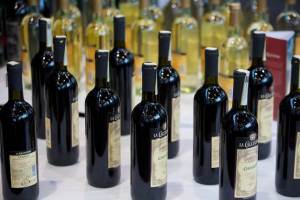Enjoying a glass of wine after a long workday or while eating dinner often proves irresistible to many: consumers in the U.S. now comprise the biggest chunk of the global wine market, drinking 13% of the world’s wine, according to analysis by a wine industry expert. The 6th Annual New York Wine Expo recently took over the Jacob K. Javits Convention Center in a frenzy of tasting and tippling, and National Wine Week is upon us (March 11-15), which features discounted pours at upscale restaurants around the country. Here are six trends in the wine industry that are taking off this spring:
- Consumers reaching beyond the Old World stalwarts in search of undiscovered gems
The Wine Expo saw a strong subset of exhibitors from Eastern Europe and the Middle East, such as Bulgaria’s Izba Karabunar , Lebanon’s Ixsir and Greece’s Chatzivaritis, who aim to capitalize on increasing consumer interest in discovering wines that are new to the American market. Even within the Old World, Portugal is making a substantial push to come out of the shadows of the other European heavyweights. Portugal is known for blended wines that pair very well with food, and in an effort to appeal to the international market, “producers [of late] try to make blends of fewer grapes, so it can be easily understood what each grape gives to the wine,” says Miguel Nora, Wines of Portugal’s North America manager. (Nora recommends the Alvarinho and Touriga Nacional varietals as his personal Portuguese favorites.)
- Rise of Finger Lakes wines
As consumers look increasingly to locally-sourced wines, bottles from the Finger Lakes are becoming a go-to for wine drinkers in the New York metropolitan area and beyond. “They offer quite a bit of value, even compared to their cousins in the Old World,” says Thomas Pastuszak, wine director of New York City’s NoMad hotel and restaurant. With over 100 wineries, the region’s cool climate makes it ideal for a number of varietals, particularly Riesling. “Finger Lakes Rieslings are really pushing the envelope in terms of what different quality and character can come from that grape,” Pastuszak continues. Dr. Konstantin Frank produces world class Rieslings as well as Gewürztraminer, and was named the 2012 Winery of the Year from NY Wine & Food Classic. Another notable bottle is Fox Run Lemberger, a rich spicy red from a grape that is native to Central Europe, but is starting to take hold in the Finger Lakes.
- The rosé renaissance
Often derided as an overly sugary, unserious wine, rosé is in the midst of a comeback. Forget about the white Zinfandel blush wine that your mother used to drink—the new rosés are less sweet and cloying while still retaining a refreshing character. Pastuszak explains rosé 2.0 as “beautiful, dry, really expressive wines—basically like white wines that drink with a little bit of red wine character.” These new rosés will be perfect on a sunny summer day. Check out Goldeneye 2011 Vin Gris of Pinot Noir or Graham Beck 2007 Brut Rosé, a sparkling version from South Africa.
- New grape varietals being grown in California as youthful winemakers take root in the area
Traditionally Chardonnay, Merlot and Cabernet Sauvignon have been the hallmarks of California wine production. But many vintners are looking beyond this triumvirate and exploring new blends and grape varietals—Pinot Grigio, Tempranillo and Petite Syrah, to name a few—previously unknown to the area. A new generation of young winemakers are bringing an experimental, innovative sensibility to this pursuit as they exploit the state’s temperate climate and fertile soil—orthodoxy be damned! Several to look for are the Scholium Project’s Prince in His Caves, an exciting sauvignon blanc, and Aaron Wines’ Petite Syrah.
- Expecting higher quality at a lower price point
As consumers become better educated and more sophisticated about wine, they are seeking out good value bottles that don’t skimp on quality. Dollar for dollar, they are no longer satisfied with a wine that’s just mediocre. “That ten dollar bottle needs to taste like that twenty dollar bottle used to,” declares Pastuszak. This is good news for the rising players in the market, like the Portuguese wine industry, says Nora: “The [global economic] crisis was not good for anyone, but it could be worse for us, because our price quality is very good. We already had the quality, and in the last few years, maybe because of economic issues, [consumers] tried it more and now they keep buying it.”
- Grower champagnes
Most imbibers think of champagne as a fancy, expensive bottle to be uncorked on a special occasion, but not something to pair with food or even to be had at a less-than-expense-account price. That is all changing, however, with the advent of grower champagne, which is bubbly grown and bottled from small grape growers in France’s Champagne region. Though many of these indie vineyards sell the majority of their grapes to companies like Moët & Chandon and Perrier Jouët, some are starting to produce and bottle their own champagne on the side, with exciting results. Instead of a standardized flavor that is specific to each big brand, grower champagne reflects more of the terroir and thus its vintages exhibit greater variety. “Ten years ago you couldn’t find this variety and assortment,” says Pastuszak. “But today it’s like finding great small-farm produce at the farmers’ market.” Look for grower champagnes by Vouette & Sorbée, Drappier, or Vilmart & Cie.


